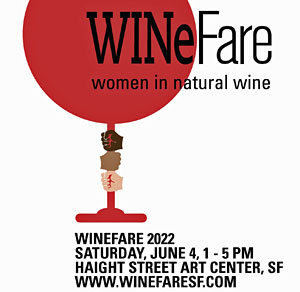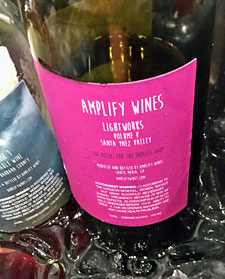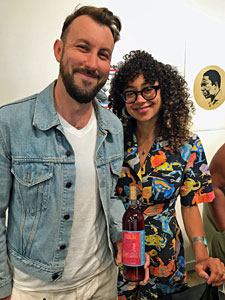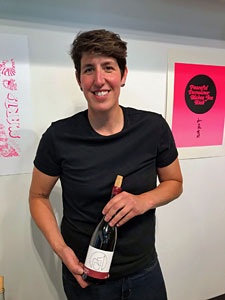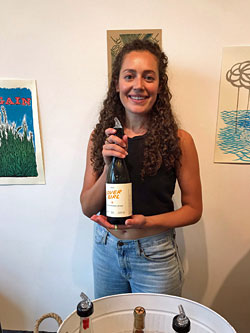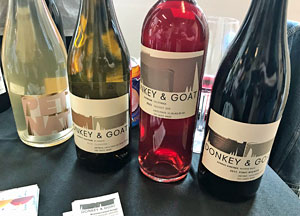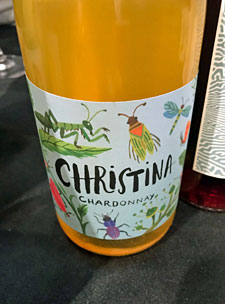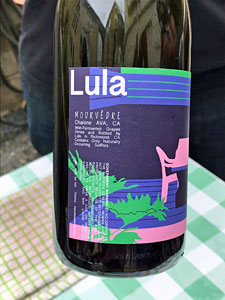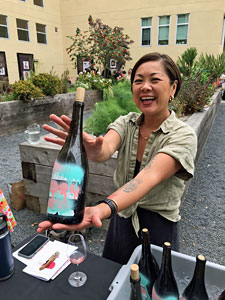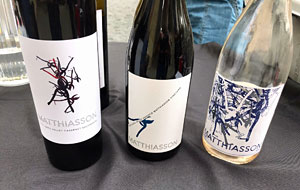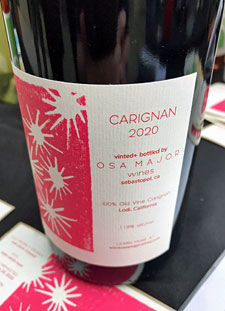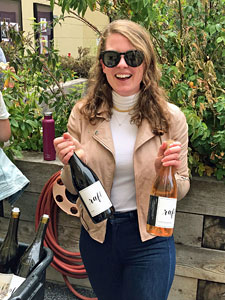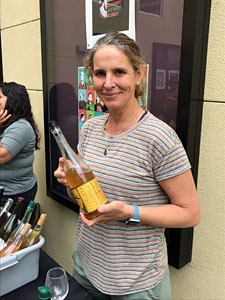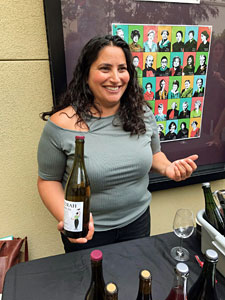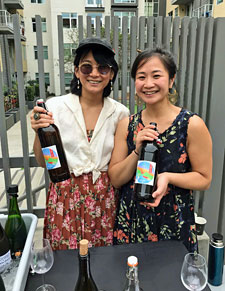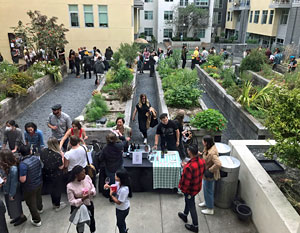Accenti / Thereafter Wines
Accenti and Thereafter are the labels of Lorenza and James Allen, and they make their wines in Santa Rosa. My favorite wine at this table was the Accenti 2021 California Rosé of Barbera, fermented and aged in neutral oak. This displayed red fruit with floral accents, bright acidity, and a long lively finish.
Amplify Wines
Marlen Porter and her husband Cameron are both from Santa Barbara County and both share a love of both wine and music. They launched their Amplify label in 2013, and make their wines using mostly Santa Barbara County vineyard sources. The NV “Lightworks Volume V” Merlot, sourced from Coquelicot Vineyard in Santa Ynez Valley, was made in a Solera method and includes vintages ranging from 2014 to 2020. Bright plummy fruit with savory herbal notes and spice in support, with a nice texture and pleasant finish.
Ashanta Wines
The grandparents of Chenoa Ashton-Lewis planted a vineyard on Sonoma Mountain in the early 1970s and her family has been involved with wine ever since. She and Will Basanta made their first wine in 2019 and launched Ashanta Wines the following year. They make their wines in Sebastopol. The 2020 “Huzzah” Sparkling Colombard, sourced from Solano County Green Valley and just disgorged the previous day, featured apple and pear fruit, a lightly sparkling mouthfeel, and a clean dry finish. The 2021 “Mermejita” is a Marsanne-Viognier co-fermented for one week on the skins, from a vineyard only five miles from Mexico in California’s South Coast wine region – this had stone fruit and floral aromas with savory undertones, medium weight, and a touch of chalky tannin on the finish. The 2021 “Resist” Rosado, a Syrah-Mourvèdre co-ferment sourced from the Templeton Gap area of Paso Robles, was savory, with cherry and earth notes, nice texture, and a lively finish.
Birdhorse Wines
Established in 2018, Birdhorse is the label of Corinne Rich and Katie Rouse. Both have worked at a number of wineries in the US and abroad, and in addition to Birdhorse they have day jobs as assistant winemakers, each at highly-regarded wineries in Sonoma. Corinne poured me the Birdhorse wines at the tasting. The 2021 Contra Costa Verdelho came from Avina Vineyard, close to the San Joaquin River delta near Knightsen – this featured bright green apple and citrus aromas with floral notes, medium-light texture, and crisp acidity on the finish. The 2021 Suisun Valley Valdiguié, sourced from 40-year old vines and fermented with 30% whole clusters, had lots of upfront berry fruit along with spice and floral aromas and savory undertones, with a lively mouthfeel and finish.
Carboniste
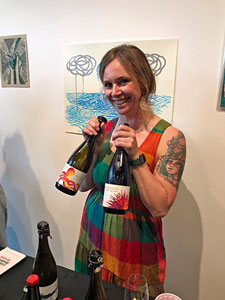 |
Carboniste was launched in 2017 by the husband-and-wife team of Dan & Jacqueline Person. They make exclusively sparkling wines, using a variety of methods. Mara Ambrose of the Carboniste winemaking team poured the wines at the tasting. The 2021 Gomes Vineyard Sparkling Albariño came from a dry-farmed site on Andrus Island in the Sacramento River Delta – this had bright upfront stone fruit and tropical fruit aromas with floral undertones, and a fresh clean mouthfeel and finish. The 2021 Sparkling Rosé of Pinot Noir, with fruit sourced mostly from the Santa Cruz Mountains plus some from San Benito County, showed red fruit plus a slightly savory character on the nose, with fine bubbles and a crisp finish. The 2019 “Marin” Brut Rosé, sourced from two Marin County vineyards, spent more time in barrel and in bottle before release than the previous two wines, and it showed a more “serious” sparkling wine character – less fruit-forward with more savory, earthy, and yeasty notes, a creamier texture and fuller finish.
Catch and Release Wines
Monica Varriale and Beno Stewart started Catch and Release in 2018, with their first commercial vintage the following year. The wines are made in Napa. The 2021 “Middle Child” Riesling from Gustafson Vineyard in Alexander Valley was made with some skin contact, and displayed a savory note along with citrus and floral aromas and a lively mouthfeel. The 2020 “Lover Girl” Pinot Gris came from Filigreen Farm in Anderson Valley, and was whole-cluster pressed and aged in neutral oak – this had stone fruit and spice on the nose with medium-light weight and a fresh finish. Monica poured two contrasting Pinot Noirs, both sourced from Filigreen Farm – both were nice, and my favorite of the two was the 2020 “Well Rested” Pinot Noir. Mostly from Dijon clones, fermented with 50% whole clusters, and aged in neutral oak for 18 months, this had upfront fruit aromas along with earth, leather, and forest floor, medium body with good structure and moderate tannins.
Donkey and Goat Wines
Donkey and Goat was established in 2004, one of the earlier California wineries specializing in natural wines. The wines are made in Berkeley, and the focus is mainly on wines from Rhône varieties. Owner/winemaker Tracey Brandt was at the tasting. The 2021 “Lily’s Pet Nat” Sparkling Chardonnay, from 40-year old vines at Conzleman Vineyard in Anderson Valley, had upfront pear and spice aromas with floral undertones, fine bubbles, and a bright clean finish. The 2021 “Skinny Dip” Grenache includes Grenache Gris from Gibson Ranch in Mendocino County and Rosé of Grenache from Girard Vineyard in El Dorado County, aged six months in neutral oak. This displayed bright red fruit, fresh herbs, and spice on the nose, with lively acidity and fine tannins on the finish.
Fattoria La Maliosa
Run by Antonella Manuli, Fattoria La Maliosa is a 160-hectare farm in Tuscany that has produced winegrapes, olive oil, and honey since 2009. The farming is certified organic. The 2020 “Saturnalia Bianco” is a blend of 50% each Procanico and Trebbiano, fermented on the skins for about three weeks and then aged in neutral oak. This had stone fruit, orangepeel, and spice aromas with medium weight and a moderately chalky tannic finish.
Floraison Selections
Based in California, Floraison Selections was founded in 2017 by Nadia Dmytriw, who has worked in the wine industry since 2001. Importers and distributors, they represent French producers from a number of regions – at this tasting Nadia presented wines from Provence and the Loire Valley. The Domaine de Sérol 2020 “Eclat de Granite” Côte Roannaise, from 80-year old Gamay vines on granite soil, was fermented with 50% whole clusters – this had savory red fruit, earth, and stony mineral undertones, with nice structure and a bright finish. The Domaine l’Austral 2019 “Manta” AOC Saumur Puy-Notre-Dame is Cabernet Franc and also fermented with about 50% whole clusters. Black cherry, savory dried herbs and earth, medium body with a lively texture and moderate tannins. The Domaine de Sérol “2020 Turbullent” Côte Roannaise, a sparkling Gamay rosé made by méthode ancestrale, had red fruit and stone fruit notes with a bright, lightly sparkling mouthfeel and clean finish.
J. Brix Wines
 |
Based in Escondido in northern San Diego County, this is the label of husband-and-wife team Jody and Emily Towe. Their first commercial vintage was in 2010, and they source fruit mostly from the Central Coast and increasingly from vineyards in San Diego County. The 2021 “Uncontainable” Rosé of Cinsaut, from Hagata Vineyard in San Diego County, was very light in color, with bright but subdued red fruit, earth, and herbs on the nose, a lively texture, and fresh finish. The 2020 “Limestone + Schist” Old-Vine Chardonnay was sourced from Rorick Heritage Vineyard in Calaveras County and aged in neutral oak – it featured bright pear and stone fruit, flowers, and spice aromas, with medium weight and a long finish. The 2020 “La Belle Rêveuse” Syrah, from Coquelicot Vineyard in Santa Ynez Valley, was entirely destemmed, and aged in neutral oak. It was savory and spicy, with dark berry fruit and hints of black pepper, nice structure and texture, with fine tannins – nice now and should benefit from some time in the cellar.
Jenny & François Selections
Natural wine importers based in New York City, Jenny & François Selections was co-founded in 2000 by Jenny Lefcourt, who continues to run the business. I only tasted one wine from them, but it was a good one. The Christina 2020 Chardonnay, made by Christina Netzl in the Carnuntum wine region of Austria, was skin-fermented. It displayed savory herbal aromas along with stone fruit and orangepeel notes, medium weight on the palate, and a pleasant tannic touch on the finish.
Lula
Owner/winemaker Megan Sekermestrovich launched her Lula label with the 2019 vintage, and she makes her wines in Richmond, California. The 2021 “Heart of the Valley” is a co-ferment of 75% Syrah from Love Ranch in Madera County and 25% Chardonnay from Lolonis Vineyards in Redwood Valley – this displayed bright stone fruit and red fruit aromas with floral undertones, and a lively texture and finish. Even better was the 2021 “Table Talk” Mourvèdre from Rodnick Farm in the Chalone AVA of Monterey County, with savory plum fruit, earth, and spice, medium weight, and a long finish with firm tannins – very tasty now, and it should develop nicely with a few years of cellaring.
Maison des Plaisances
Coral Wang was on hand to pour her inaugural release – her wine bottles for this event were beautifully hand-painted. The 2021 “Cuvée No. 1” comes from vineyard near Cloverdale in Sonoma County that Coral pointed out has a Chinese-American winegrower, a rarity. Made with partial carbonic fermentation from 50% Grenache, 24% Syrah, 24% Mourvèdre, and 2% Zinfandel, it featured bright red fruit, spice, and earth, with good texture and fine tannins.
|
Margins Wine
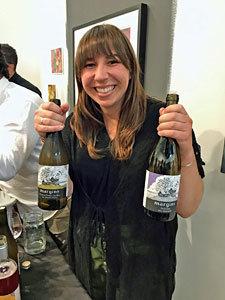 |
Owner/winemaker Megan Bell launched her label in 2016, after working in wineries and vineyards in California, Oregon, New Zealand and the Loire Valley. She makes her wines at a shared facility in southern Santa Cruz County. The 2021 Skin-fermented Chenin Blanc, sourced from Wilson Vineyard in Clarksburg, was fermented on the skins for 23 days and aged in neutral oak, and featured savory and umami notes plus stone fruit and a touch of spice, with nice texture on the palate and finish. The 2021 Muscat Blanc from Cecchini Vineyard near Brentwood in Contra Costa County was partially skin-fermented, and had Muscat’s distinctive floral aromas but they didn’t dominate the wine. The 2021 “Neutral Oak Hotel” includes 24% Mourvèdre, 23% Pinot Noir, 12% Chenin Blanc, 8% Barbera, 8% Grenache, 7% Cabernet Sauvignon, 7% Nebbiolo, 6% Merlot, and 5% Counoise – quite a blend! This displayed bright red fruit, flowers, and herbs on the nose, with a vibrant mouthfeel, a fun light chillable red. The 2021 Grenache from Paicines Ranch Vineyard in the Paicines AVA of San Benito County had upfront cherry and raspberry fruit with medium-light weight and a lively finish.
Matthiasson Wines
Well-known Napa-based viticulturist Steve Matthiasson and his wife Jill produced their first commercial vintage in 2003. In addition to purchased fruit, they also have their own Napa vineyard, which includes Ribolla Gialla, Refosco, Schioppettino, Merlot, and Petit Verdot. The 2021 Rosé is a blend of 40% Grenache, 18% Barbera, 16% Counoise, 14% Syrah, and 12% Mourvèdre, from several vineyards, and aged in stainless steel drums – this had citrus and watermelon aromas with hints of herbs and flowers, and lively acidity. The 2020 Matthiasson Vineyard Refosco, aged in neutral puncheons, had earthy dark berry fruit and a stony mineral quality, medium weight, and good structure for aging. The 2019 Napa Valley Cabernet Sauvignon, from three vineyards, is 86% Cabernet Sauvignon, 5% Cabernet Franc, 5% Merlot, 2% Malbec, and 1% Petit Verdot. This was bright and herbal, showing black cherry fruit and a touch of oak in the background, with a lively mouthfeel and finish.
Onward Wines
Owner/winemaker Faith Armstrong established her Onward Wines label in 2009. The Onward wines are focused on single vineyard sources, while wines from her companion Farmstrong Wines label are blends. The 2021 Pétillant Naturel Sparkling Rosé of Pinot Noir comes from Hawkeye Ranch in Redwood Valley, and displayed strawberry and stone fruit aromas with floral notes, fine bubbles, and a crisp clean finish. The 2020 Johnson Family Ranch Chardonnay from Mendocino County was aged in neutral oak – this had subdued pear and floral notes on the nose, medium texture on the palate, and a slightly chalky character on the finish. The 2021 “Nouveau Style” Zinfandel featured lots of upfront berry fruit with herbal undertones, and juicy acidity, a fun and fresh chillable red.
Osa Major Wines
Osa Major owner and winemaker Emily Fernwood worked harvests all over the world before launching her own label in 2020. She makes her wines in Sebastopol. My favorite of the Osa Major wines was the 2020 Old Vine Carignan – sourced from 90-year old vines at Lodi’s Mule Plane Vineyard, this was a lighter rendition of the variety and displayed bright and savory red fruit and earth aromas, a lively mouthfeel, and moderate tannins on the finish.
Raft Wines
Jennifer Reichardt launched her Raft label in 2016, and makes her wines in Santa Rosa. Vineyard sources for the Raft wines range from the Sierra Foothills to Sonoma and Mendocino counties, and to date, most of the wines are made from Rhône grape varieties. The 2021 “Fleur Pour Ma Mère” Rosé comes from Grenache fruit at Trails End Vineyard in Mendocino County’s Potter Valley, and was aged in neutral oak. Bright strawberry and floral aromas, this had medium weight with lively acidity and a long clean finish. The 2019 Weed Farm Syrah from Dry Creek Valley showed plenty of savory and spicy dark fruit along with black pepper and earth, medium-full mouthfeel and firm tannins – this should develop nicely with more bottle age. Jennifer also has a new project called Little Trouble, made with her friend Sara Morgenstern – the Little Trouble 2021 Carbonic Zinfandel, from Gist Vineyard in Dry Creek Valley, displayed bright upfront red berry fruit with a vibrant texture.
Rock Paper Scissors Wine Imports
Rock Paper Scissors was established in Napa Valley in 2019 by Ashley Taranto and Federico Parlagreco. I particularly enjoyed two wines at their table. The Thomas Niedermeyr 2017 “14” Solaris, from Alto Adige in Italy, is made entirely from the Solaris grape variety. This is one of a number of “PIWI” varieties from Europe that are hybrids of vitis vinifera varieties and North American varieties in order to create vines resistant to fungus and other issues. This had pear and spice aromas, a lively mouthfeel, and a long clean finish. The Vigna Nica 2020 Mamertino Bianco is a blend of 60% Grillo and 40% Ansonica (aka Inzolia or Insolia) from the Mamertino DOC in Sicily and made in stainless steel. Bright citrus, herb, and floral notes with vibrant acidity and a crisp finish, very pleasant.
Roni Selects
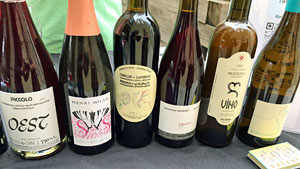 |
Roni Ginash launched her Los Angeles-based import and distribution company in 2017. This was the first table I stopped at during the tasting, and all four of the wines I tasted there were very good. The Domäne Vincendeau 2018 “Le Raguenet” is a Loire Valley Chenin Blanc, made in stainless steel – fresh citrus and stone fruit aromas with a stony mineral note. The Artana 2020 Rkatsiteli, from the Kakheti region in Georgia, spent about six months on the skins in qvevri. Cloudy with a bit of funk on the nose along with stone fruit and the phenolic character of skin-fermented whites, this finished with significant tannins. In fact, it may have been more tannic than the Kortavebis Marani 2020 Chinuri & Saperavi, another wine from Kakheti and a 50/50 blend of the two varieties – this had bright savory and floral aromas along with darker fruit. The Domaine Henri Milan 2019 Brut Rosé, mostly Grenache plus Syrah and Alicante from Provence and made with no dosage, had upfront red fruit, a slightly creamy texture, and a dry and vibrant finish.
Solminer Wine Company
Anna DeLaski and her husband David have a small vineyard in Santa Ynez Valley, and the first vintage of Solminer wines was in 2012. Anna is originally from Austria and the label focuses largely on wines from Austrian grape varieties – she was on hand to pour their wines. The 2021 Santa Barbara County “Sunhoney,” a blend of 55% Grüner Veltliner, 35% Riesling, and 19% Viognier was fermented on the skins for two weeks and aged in neutral oak – this had citrus and orangepeel aromas, spice, and plenty of bright acidity, with a touch of chalky tannin on the finish, very distinctive. The 2021 deLanda Vineyard Skin-fermented Grüner Veltliner, from the DeLaski’s estate vineyard, was more savory and herbal, with green apple and citrus fruit and fine texture on the palate. The 2021 Los Olivos District Carbonic Syrah displayed bright, vibrant red fruit along with savory background notes and a lively mouthfeel and finish, a fun rendition of Syrah.
Terah Wines
A certified sommelier as well as a winemaker, Terah Bajjalieh worked in the restaurant business, wine education, and over a dozen winegrape harvests in California, Oregon, France, Argentina, Australia, and New Zealand. She launched her wine label in 2020. All of her wines were nice, with two that I thought were particular highlights. The 2021 Pétillant Naturel is from 50% each Pinot Noir and Chardonnay sourced from Santa Clara Valley – this featured bright red fruit and stone fruit aromas with good texture and a long clean finish. The 2021 Clements Hills Vermentino, from Bench Vineyard in the hilly eastern part of Lodi, had upfront citrus and herb notes with touches of flowers and stony minerals, with a vibrant mouthfeel and finish.
Tessier Winery
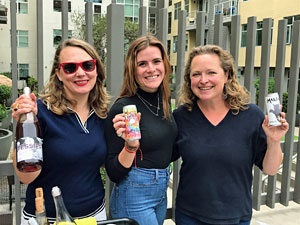 |
| (l) Kristie Tacey of Tessier; (r) Karen Daenen of Two Shepherds |
Owner/winemaker Kristie Tacey has a background as a research scientist, and she established the Tessier label with the 2009 vintage. She makes a range of wines, mainly Riesling, Pinot Noir, Grenache, Cabernet Franc, Gamay Noir, and Mourvèdre, plus blends. The 2021 “Electric Ladyland” is a blend of 60% Albariño, 15% Chardonnay, 10% Pinot Gris, 10% Pinot Noir, and 5% Riesling with varying amounts of skin contact – this had upfront stone fruit and tropical fruit aromas along with savory herbal notes, medium-light weight on the palate and a lively finish. The 2021 “Soul Love,” from 70% Riesling, 25% Mourtaou, and 5% Merlot, featured bright red fruit and flowers on the nose plus earthy undertones, with nice acidity – a light fun wine with some structure too. I finished with the 2021 Siletto Vineyard Mourtaou (aka Cabernet Pfeffer) from San Benito County, made with 50% whole-cluster fermentation and aged in neutral oak and stainless steel. This was earthy and herbal, with red fruit, spice, and a distinct note of jalapeño, with medium weight and firm tannins – should be worth giving this a bit of time in the cellar.
Two Shepherds
Two Shepherds co-proprietor Karen Daenen and her husband William Allen make their wines in the town of Windsor in Sonoma County. They started out with a focus on Rhône varieties but have branched out to a number of others as well. Karen poured three wines in their new 250ml cans, all nice, with a couple of standouts. Typical of piquettes, the 2021 “Maxzilla” Sparkling Piquette is low-alcohol, this one only 7.5% – made from carbonic Carignan skins and water, it displayed black cherry and earth aromas, a pleasant fizz, and lively finish. The 2021 “Bucking Luna” Carbonic Cinsault-Carignan is 40% carbonic Carignan and 60% Cinsault rosé – plummy, earthy, and spicy, with a vibrant texture and finish. I’ve enjoyed the previous “Bucking Luna” canned wines and this one may be the best yet. The lone bottled wine at the Two Shepherds table was the 2021 “Wiley” Carbonic Carignan, from Trimble Vineyard in Mendocino County and made entirely in stainless steel, had juicy red berry fruit and savory notes, with great acidity and a fresh finish.
Yamachan Wine
Akari Yamamura has worked at restaurants and wine shops, and made her first Yamachan wine, a Gewürztraminer, in 2019. Her day job is at Donkey & Goat in Berkeley. Akari and Delia Sie poured the wines at the tasting. The 2021 Skin-contact Chenin Blanc from Clarksburg featured savory citrus and pear aromas with a touch of funk and a lively texture and finish. Akari also has a collaborative project with Horsefeathers Wine, and she poured their 2021 Pinot Blanc from Mendocino County – this had stone fruit and earth on the nose with medium weight on the palate.
|


